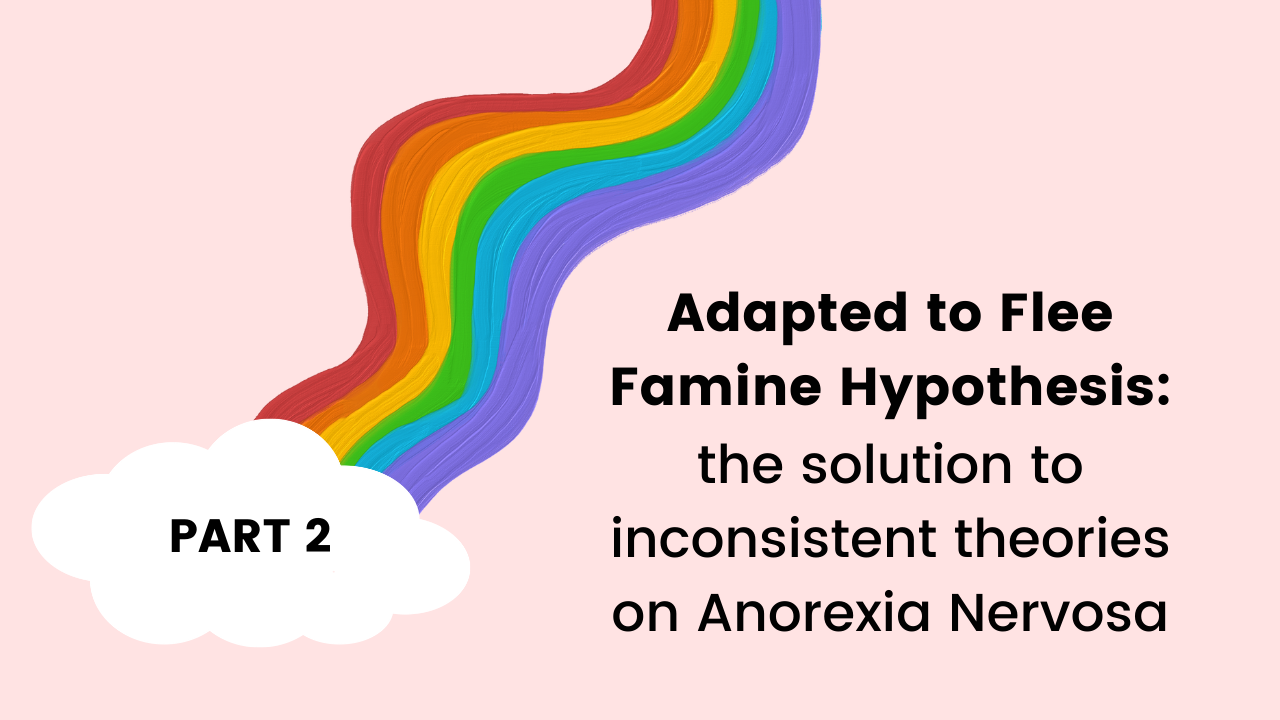The SOLUTION to Inconsistent Theories on Anorexia Nervosa (Adapted to Flee Famine Hypothesis PART 2)
Mar 18, 2022
Welcome to part 2 of my series on the evolutionary biology of Anorexia! In part 1, I shared my personal experience with Anorexia and how I never resonated with the stereotypical beliefs around the illness. In this post, I’ll be explaining 4 current theories of which most treatments for Anorexia are based off, and why each theory lacks in creating a comprehensive understanding of the paradoxical disease. The 4 theories are categorized as psychoanalytic, social, biomedical, and evolutionary. Be sure to subscribe to stay up to date on upcoming posts and without further ado, let’s get into it!
1. Psychoanalytic Theories
First up, Psychoanalytic Theories! Psychoanalysis is probably the most popular form of treatment for eating disorders today; think DBT, CBT, or any other forms of traditional talk therapy. Psychoanalytic Theories for Anorexia mainly have their roots in the works of Sigmund Freud and Hilde Bruch.
The term anorexia nervosa literally means lack of appetite because of nerves, and researchers have searched diligently for psychological antecedents.
Sigmund Freud
Sigmund Freud wrote “the well-known anorexia nervosa of girls seems to be a melancholia occurring where sexuality is undeveloped” and believed the illness resulted from unconscious conflict over sexual drives or as a defense against fears of oral impregnation.

To elaborate, Freud saw eating and sex as symbolically related. He believed that girls may link gaining weight in the stomach area with that of pregnancy at an unconscious level, and refusing to eat was a way in which a female refused to accept her developing sexuality. He then goes even further with this theory in stating that food refusal is a girl’s way to remain immature, so she doesn’t have to accept the responsibilities that come with adulthood.
Hilde Bruch
Hilde Bruch, on the other hand, proposed that food refusal represents a struggle for psychological autonomy and control. The whole concept of Anorexia being the result of bad parenting is thanks to Bruch’s theories.
Bruch argued that anorexic patients “engaged in a desperate fight against feeling enslaved and exploited” caused by overly controlling parents that would supposedly limit the child’s opportunities to function autonomously.

From this perspective, an adolescent’s fixation on body weight is used a means to compensate for the lack of clear identity and for associated feelings of powerlessness and incompetence.
Bruch’s theories provided the conceptual framework for psychodynamic and family systems work that followed, which can be summarized by the notion that the dysfunction of a child’s (mental) health is the direct result of dysfunctional family dynamics.
Psychoanalytic Theories Inconsistencies
Clearly, a number of facts do not line up with these traditional psychological explanations. In an attempt to find evidence to support the psychoanalytical theories, researchers have extensively studied parents of people with anorexia throughout the past several decades. According to Freud and Bruch’s theories, the pathology of the studied parents would explain their child’s terrible illness, as well as those of autistic and schizophrenic adolescents.
In the autistic community, the term “refrigerator mothers”, coined by Austrian psychiatrist Leo Kanner in the 1940s, has been used to describe a mother whose cold, uncaring style traumatized her child so much that they would have retreated into autism.
Just as the refrigerator mothers term has long been debunked, the families of anorexic patients do not reliably demonstrate serious psychopathology, let alone the specific psychopathology hypothesized by Bruch and others! In fact, the majority of parents were found to be loving, gentle, and supportive of their child.
Furthermore, the commonly considered belief “refusal to maintain a normal bodyweight” and “excessive fear of gaining weight” do not align with the reality of the manifestation of the eating disorder.
In my personal experience as well as my experience in working with clients through 1:1 coaching, I know that the majority of individuals suffering from Anorexia desperately want to gain weight, yet have an enormous difficulty eating more and exercising less.
The apparent inability to gain weight, thus, seems to stem more so from a biological drive than psychological one. On top of this, an “intense fear of gaining weight or becoming fat,” is not not always characteristic of patients with AN. I myself never struggled with body dysmorphia, yet I still had Anorexia!
Aside from unreliable claims made about anorexia being caused by bad parenting and a “desire for thinness”, there are several more reasons to doubt purely psychological theories of etiology. Despite most theoretical assumptions, the symptoms of AN are similar in men and women. Not only pubescent girls develop anorexia, because as we all know, eating disorders do not discriminate!

The symptoms used to explain why the illness is present in adolescent girls does not make sense for males, postmenopausal women, or members of the LGBTQ+ community. For example, according to Bruch, refusing food is theorized to be an attempt to gain autonomy in an overly controlling family system. How are researchers to understand that symptom from a purely psychological perspective when the patients live alone and have no family? Not to mention, the Freudian theory describing fear of fatness to equate an underlying fear of becoming pregnant obviously does not apply to males or members of the LGBTQ+ community!
2. Social Theories
Speaking of this clear gap between anorexia supposedly being a female illness and the reality of its manifestation, it’s time to discuss social theories! According to social theorists, anorexia would be a hunger strike against a sexist and oppressive culture. Because western patriarchal culture offers girls few outlets for autonomy, self-starvation becomes part of their struggle for liberation.
Although these social theorists’ observations help to understand what initiates some women’s progression into AN, these observations are far from sufficient in forming a comprehensive theory for the development of the eating disorder. Just as with the psychological theories, the social theories fail to account for the occurrence of anorexia-like syndromes in other animals, in other genders, and at other times. Not to mention, they completely lack in explaining body dysmorphia and hyperactivity, two highly frequent characteristics of anorexia.
All that to say, social theories can explain why women and girls are more vulnerable to develop AN. Feminist social critics have gently pointed out that the fashion and entertainment industries promote an ideal size that is impossible for most women to maintain, with female fashion models generally weighing about 85% of their average bodyweight.
Although some women are naturally very thin, the majority of women would have to starve themselves to attain the current standard of beauty. There is a general consensus that this modern pressure on women to diet has contributed to the increasing incidence of eating disorders specifically among women and girls, but again, a huge group of people is being overlooked here: not only males, but also members of the LGBTQ+ community!
3. Evolutionary Theories
Finally, we are getting into evolutionary theories, which were first noted in 1984. This is not yet the Adapted to Flee Famine Theory, as there are several inconsistencies in the works of early evolutionary theorists studying anorexia.
One of these theorists was Randolph Nesse, who noted that the “remarkable consistency of this syndrome suggests the presence of a possible adaptive mechanism”.

Although this is definitely a step in the right direction, Nesse focused solely on the loss of menses in female anorectics and speculated that AN functions to delay reproduction.
Reproductive Suppression Hypothesis
This theory, named the Reproductive Suppression Hypothesis (RSH), posits that adolescent girls’ desire to control their weight represents an evolutionary adaptation by which females reduced the rapidity of their sexual maturation in response to cues about the probability of poor reproductive success.
The RSH is obviously supported by the fact that menarche (getting your first period) is delayed in prepubescent girls with AN, and that menses cease altogether in previously menstruating females suffering from anorexia.
Presumably, starvation cues could indeed have been indicative of poor times for reproducing, and the RSH illustrates a valid point. However, just as with the statements made by social theorists about anorexia and other eating disorders being caused by “a man’s world”, this reproductive theory does not help to understand the function of distorted body image and hyperactivity, why other less costly ways to stop menstruation were not selected for, why wealthy well-fed women and girls might expect poor reproductive success, or why AN’s victims also include postmenopausal women, men, and non-binary individuals. In the upcoming posts I will be explaining an alternative evolutionary theory with is the Adapted to Flee Famine Theory, but I did promise to tell you about 4 different types of theories first!
4. Biomedical Theories
The fourth and final genre of theories you’re going to learn about are the Biomedical Theories. When working from a biomedical perspective, researchers perceive a biological origin of a disorder or illness, believing symptoms to be the result of pathophysiological processes and not of adaptive mechanisms. Considering evolution has an enormous impact on our current biological processes, I’m sure you can imagine that biomedical theories often lack in fully encompassing the etiology of a disorder!
Although Anorexia’s origin remains unknown, biomedical researchers have hypothesized that AN may result from inherited abnormalities in the endocrine system and the neurotransmitters involved in appetite. A number of hormones and neurotransmitters have been found in abnormal concentrations in individuals with AN, and there are several twin studies illustrating the increased heritability for anorexia and other eating disorders.
Biomedical Theories Inconsistencies
However, the neuroendocrine abnormalities in patients with anorexia are distinctly different than when abnormalities are observed in a non-eating disorder malnourished person. To elaborate, it is of course completely natural for hormones and neurotransmitters to shift when one is malnourished; this is simply a result of starvation. Nevertheless, a key difference can be observed between individuals who are malnourished without an eating disorder, and those with active anorexia.
In “normal” starvation, the pattern of neuroendocrine changes often leads to lethargy and hunger, not hyperactivity and prolonged food refusal. It’s of course these fatal behaviors that make Anorexia such a paradoxical illness!
When body weight normalizes, most of the “defects” that occur as a result of starvation resolve, implying that the neuroendocrine imbalances cannot be attributed to inherited abnormalities alone.
So, rather than interpreting the neuroendocrine abnormalities as dysfunctions or as secondary factors, it may be more appropriate to view them as evolved mechanisms to facilitate fleeing from famine, which you can read all about in Part 3 of my Adapted to Flee Famine Hypothesis series!
In the next post, I’ll be explaining everything you need to know about the Adapted to Flee Famine Hypothesis, so be sure to subscribe to my newsletter to be notified when it goes live!
Adapted to Flee Famine Hypothesis FULL TEXT




